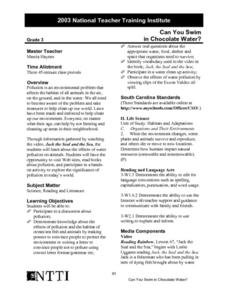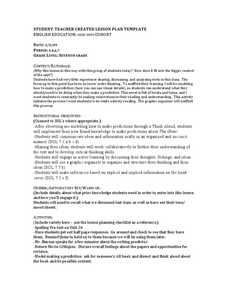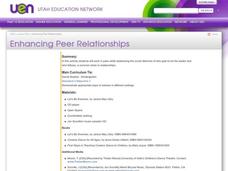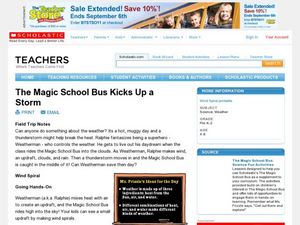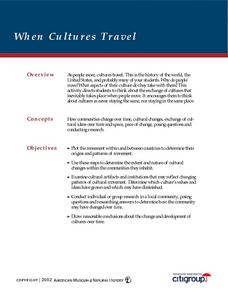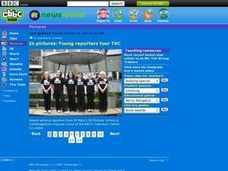Curated OER
Toilet Paper Solar System
Students create a model of the distances of the planets in the solar system using sheets of toilet paper and markers. Generally accepted orbital parameters are applied.
Curated OER
Contaminated Drinking Water
Pupils see if they can tell if our water is safe to drink by looking at it and tasting it. They perform an experiment using salt and vinegar to see when they can tell water has been contaminated.
Curated OER
Creating an Autobiography
Young scholars create technology based portfolios for others to use as a pattern for assessment. They make a "Personal Autobiography Page" to start the portfolio.
Curated OER
Meet the Royal Food Family
Second graders use mini-books, posters, songs, trading cards and sorting activities to explore the five food groups needed for health: vegetables, fruits, grains, milk and meat. They discuss why good nutrition is important.
Curated OER
Can You Swim in Chocolate Water?
Third graders discss water pollution and its affects on animals. They watch a demonstration using a plastic fish in a fish bowl in which various types of water pollution are illustrated.
Curated OER
The Giver
Middle schoolers read the novel The Giver and complete six tasks. They identify vocabulary that they did not recongize, create a different ending for the book, produce character cards and pick important events and objects from the novel.
Curated OER
Springtime Flower Fun
Learners study directional skills and participate in a scavenger hunt to find flowers. They compare, group and classify the flowers by their similarities and differences.
Curated OER
From Above
Students use maps and other geographic representations, tools, and technologies to acquire and report information from a spacial perspective.
Curated OER
Enhancing Peer Relationships
Students work in pairs while addressing the social dilemma of who gets to be the leader and who follows, a common strain in relationships. They, in pairs, dance to a variety of music, each taking turns being the "leader" of the dance.
Curated OER
The Magic School Bus Kicks Up a Storm
Students investigate how warm air from a lamp affects a spiral of paper. They determine how the warm air rises while cooler air moves into take its place which creates wind in this Magic School Bus activity.
Curated OER
Women In Aviation
In this aviation lesson plan, students take an electronic field trip to the Aviation Museum of Kentucjy. In the process the lesson plan looks at women in aviation history. The focus is upon how they could be considered heroes or role...
Curated OER
How Cultures Travel
Students examine how people and cultures have moved over time. They plot the movement of different groups of people and examine any cultural artifacts. They research a local group of people to determine how their community has changed...
Curated OER
Oceanography (Rivers and Streams)
Second graders examine the characteristics of streams and rivers. They identify the types of resources lakes, ponds and oceans provide. They ask questions to complete the lesson.
Curated OER
Earth's History
Seventh graders study the law of superposition by creating models of fossils in layers of rock. They examine how fossils are usually found in sedimentary rock which leads to the study of geologic history in those rocks.
Smithsonian Institution
In His Own Words: George Washington Quotation Timeline
Learners read and analyze a series of excerpts from George Washington's letters, journal, and speeches to match quotations to the event or date in his life. They identify the author or source of the historical document or narrative. They...
Curated OER
The City in Black and White and Color: An interdisciplinary approach to teaching life in the city using literature, social studies, art, and photography.
Students design an artistic and literary collage of contemporary urban life that seeks to interpret, analyze, and evaluate its mettle. They integrate their impressions of urban life with established views, thereby enriching their...
Curated OER
Climate Watch
Students participate in a national survey of biological indicators of climate change by gathering and submitting data on local plants and animals.
Curated OER
Do Plants Eat?
Students explain that photosynthesis is a process that plants use to convert light energy into glucose. They summarize photosynthesis as a chemical process in which the plant uses carbon dioxide and water to form glucose and oxygen.
Curated OER
Astronomy
Students brainstorm about what they know about the solar system. They study a planetary fact sheet and create a Venn Diagram with the information. They work in groups to examine the names of the planets and information regarding each of...
Curated OER
Who am I?
Learners develop their writing skills by creating a character sketch about themselves. Students read character sketches, view portraits by famous artists, select one personality traits, and affix a mug shot of themselves into a famous...
Curated OER
Crazy Hair
Students decorate small styrofoam cups with faces and plant grass seeds in the cups in this Science and Art lesson for the early-elementary classroom. Emphasis is placed upon the science of seed growth. The lesson includes resource links.
Curated OER
Hands That Touch The Heart
Students create Valentine's Day hearts in this variation of a classic activity for the early-elementary classroom. The "hands that touch the heart" is a great gift that can be given to family, friends, or fellow students. A materials...
Curated OER
Making The Geologic Time Scale Real
Young scholars construct a geologic timeline the size of a football field. They work in small groups to calculate the yardage for significant events in the Earth's history and then as a class pace out all of the events.
Curated OER
In pictures: Young reporters tour TVC
Young scholars view a wide range of young reporters and their accomplishments. They view all the places they toured and then analyze one particular place in pictures. Students create a portfolio out of their pictures for view.




